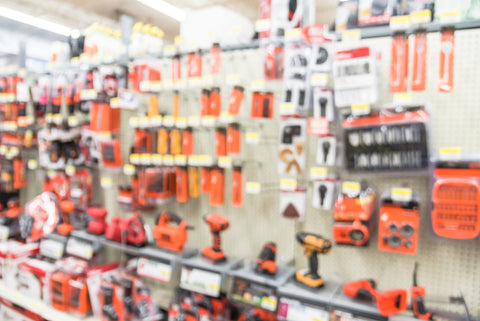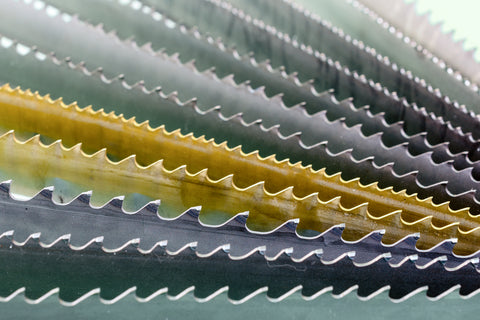There are hundreds of different saw blades on the market. The options can feel overwhelming and confusing for even the most knowledgeable contractor. Plus, the decision is getting even harder as newer tech advancements are making blades cleaner and more effective than ever.
So how do you choose the right saw blade for smooth, safe cuts? What do you need to consider when purchasing a blade for your toolkit?
1. Type of tool
First, consider the type of tool that you’re using with this blade. The four main types of saws are the table saw, radial-arm saw, chop saw, and miter saw.
Some blades are designed for a particular type of saw. It can be dangerous to use the wrong blade with your saw. For example, an oscillating tool requires an oscillating saw blade, while Sawzall blades work well for all-purpose chop sawing.
Check the saw’s manufacturer instructions for the type and size of the recommended blade. You’ll also need to consider the power of the tool.

2. Type of cut
Blades are usually broken down into three main categories based on how they cut the wood:
- Crosscutting blades chop wood across the grain.
- Ripping blades cut wood with the grain.
- Combination blades have one side for crosscutting and one side for ripping.
The type of cut that you’ll want to use depends on the material you’re working with as well as the type of project. A crosscut blade has more teeth and makes more individual cuts, so it moves through the wood smoother and at a slower rate. This typically makes it better for projects that require flat, even edges. A ripping blade has fewer teeth and moves more quickly, so it removes more material at a faster rate.
When selecting your blade, keep in mind whether you want an all-purpose blade or a specialized blade. It can take a while to change blades in between the project, thus, combination blades are often better for general use because they’re designed to do both crosscutting and ripping.
However, sometimes you may want to have specialized blades that focus on one specific type of cut to move faster or smoother.
3. Materials
What material are you cutting into?
Consider which materials you work with most frequently. Cutting into metal is different than cutting wood or plastic. Furthermore, cutting wood lumber is different than cutting wood panels.
You want to consider the type of material and how you’ll cut it. Materials include wood, metal, plastic, laminates, melamine, and non-ferrous metals.
Different blades work well for different projects. For example, BiMetal blades work well for metal and wood, while HCS oscillating blades are better for wood and plastic.
Read: Which Saw Blades Are Best For Wood, Plastic, And Metal?
4. Number of teeth
The number of teeth on your blade will determine how it will cut a specific type of material. Blades with more teeth generally have a smoother cut, while blades with fewer teeth have a rougher cut but remove material faster.
For example, a blade with 24 teeth is often used to quickly rip cut lumber for a rough foundation project that doesn’t require smooth edges. A woodworker may then switch to a blade with 80 teeth to finish off the project with a smoother crosscut that won’t splinter or tear.

5. Gullet size
The “gullet” is the space between each tooth. This is used to help remove extra material as it is cut away.
Ripping blades cut at a faster rate and the tooth size is bigger. This means that the gullet needs to be deeper to handle the greater amount of material being removed.
Crosscutting blades have smaller teeth and cut less material, so the gullet can be much smaller. Often, the gullet will be purposefully small to ensure that the feed rate isn’t too fast for the crosscutting blade to handle. This keeps it smooth and steady, especially with radial-arm saws or miter saws.
Overall, large gullets clear out more material that’s generated during ripping, while smaller gullets help slow down the feed rate during crosscutting.
6. Tooth shape
The shape and grouping of the teeth will determine how it cuts, especially with regards to ripping or crosscutting.
Flat-Top (FT) teeth have a flat top, so they’re best for roughly ripping wood. It’s the most effective design for cutting and pulling away extra material as it cuts.
Alternate Top Bevel (ATB) has blade teeth that alternate between right- and left-hand bevel. This allows for a smooth, knife-like crosscut for natural woods and veneered plywood.
High Alternate Top Bevel (Hi-ATB) is used for extra-fine crosscutting, like melamine and laminate. It has a strong hook angle with larger gullets. The high angle makes it like a sharp knife at the edge of the blade, creating exceptionally smooth results.
Combination Tooth (Comb.) works for both crosscutting and ripping. It has a grouped tooth configuration consisting of four ATB teeth and one FT tooth. There are small gullets between each tooth and larger gullets between the groups of teeth.
Triple Chip Grind (TCG) alternates between a flat raking tooth and a higher trapeze tooth. This makes it the best choice for cutting hard materials like laminates, plastics, and metals.
7. Tooth hook angle
The angle of the tooth will also impact how it cuts. Most saw blades have the teeth tipped forward or backward rather than perfectly aligned. This creates less friction and has a stronger cut.
A positive hook angle is when the teeth are tipped forward, toward the direction of the blade’s rotation. A blade with a positive hook angle will create a faster feed and more aggressive cut. A blade made for ripping lumber will generally have a high hook angle.
A negative hook angle is when the teeth are tipped backward, away from the direction of the rotation. A blade with a low or negative hook angle slows down the feed rate and smoothens the cut. For example, radial-arm saws would have a negative hook angle to offset the faster feed rate of the powerful saw.
If the teeth are perfectly aligned, it’s considered a 0-degree hook angle.
8. Kerf width
The “kerf” is the thickness of the blade. A full-kerf is 1/8” or greater, and it’s typically used on saws with 3hp or greater power motors. A thin-kerf has a blade thickness of less than 1/8”, and it’s better for portable or smaller table saws with a power of less than 3hp.
Full-kerf blades take a wider bite and remove more material at once. These are preferable for larger projects like cutting lumber.
Thin-kerfs remove less material than full-kerfs, so they require less power to operate. They also move at a slower feed rate without getting bogged down or building friction and heat. This creates less damage to the material and less wear on the saw. It also wastes less of the material.
The concern with thin-kerf blades used to be that they would vibrate at higher speeds because they were so thin. However, tech advancements have made thin-kerf blades more durable with vibration dampening systems. Today, thinner blades are often the preferred choice for most projects.
9. Tooth quality
There are two primary types of teeth: bi-metal and carbide.
Bi-metal saw blades make an aggressive cut, so they work well for larger projects. They’ll even cut through nails or other harsh materials as it goes. These are less expensive than carbide, but they don’t last as long. This is good for an at-home DIYer or for professionals looking for rough-cut blades.
Our BiMetal Japanese saw blade gets the best of both worlds. The BiMetal creates a rougher cut while the thin Japanese style allows for smooth, even strokes.
Carbide tips are higher quality and are fused to the steel blade plate. They last significantly longer than bi-metal, so long-term the cost is cheaper. These are the preferred option for most professional woodworkers.
Our HCS Quick Release blades are great for multi-use saws.
10. Blade coating
You’ll also want to consider whether your blade is coated or uncoated. Learn more about how to choose between coated and uncoated saw blades here.
Conclusion
Selecting the right blade can feel like an overwhelming process. There are a lot of factors to consider, and each project may have its own cutting needs.
Still not sure what blade is best for your toolbox?
Send us a message for a quick reply! Ask away, and we’ll make sure you find the perfect blade for your upcoming project.

Leave a comment